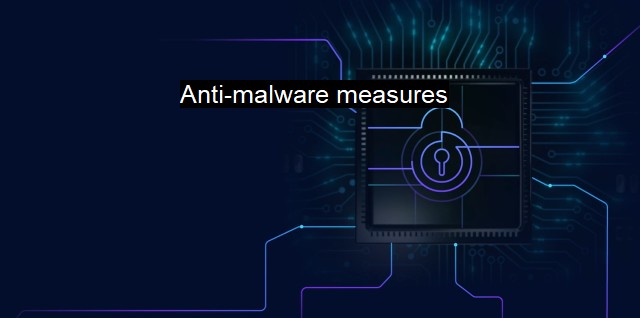What are Anti-malware measures?
Critical Anti-Malware Measures for Digital Systems: Understanding Strategies and Tools to Prevent and Mitigate Malware Attacks
Anti-malware measures refer to the combined processes and methods introduced by cybersecurity experts to detect, prevent, and clean up malicious software or malware threats on a computer system or network. The term "malware" is a portmanteau of malicious and software and includes various types of cyber threats such as viruses, worms, Trojans, ransomware, spyware, adware, and phishing. By engaging in effective anti-malware measures, individuals and organizations can protect sensitive data and ensure uninterrupted operation of their digital systems.These measures can range from the installation of security software to following exceptional browsing practices. At their base, they leverage antivirus and antimalware software. Antivirus software, in particular, was traditionally used to detect classic viruses that self-replicate after latching onto scripts. Modern antivirus applications, on the other hand, have recalibrated themselves as complete security suites armed with multiple features such as proactive malware detection capabilities, as well as protection against ransomware and phishing attacks. They scan incoming and outgoing data and entire systems for recognised threats, alerting the users if anything malicious is found utilising a comprehensive database of known threats. To stay effective, this database system must be continually updated, a feature contemporary antivirus solutions offer as an autorun function.
Similarly, anti-malware, a seemingly interchangeable term with antivirus, covers another chunk of the protection scheme. While antiviruses primarily follow a signature-based identification approach, the strength of an anti-malware tool lies in its aptitude for dealing with novel and evolving cyber threats through heuristic analysis, which is a threat-detection method that dynamically identifies unknown threats by their behaviour or file attributes.
Alongside these traditional measures, specialized anti-malware measures have also been developed to target specific threats. For instance, anti-ransomware tools can either restrict the activities of known ransomware families or prevent any unusual behaviour that may indicate an encryption manoeuvre inherent even in the unknown ransomware.
An internet connection can be deemed as the primary vector for malware distribution, anti-malware measures often involve control of network traffic and email attachments. Firewalls, either hardware or software, block unsolicited incoming network traffic, while email scanning tools monitor for spear-phishing efforts or malware-ridden attachments.
While these technical implementations form integral parts of anti-malware measures, the human factor always plays an undeniable role. The best anti-malware practices would be futile if the users fall prey to phishing scams. Therefore, education about social engineering schemes, recognising phishing emails, responsibly handling and creating strong passwords, avoiding suspicious websites and downloads, and understanding the importance of regular software updates all contribute to the complete panorama of anti-malware measures.
Lastly, a robust method employed by organizations to safeguard against potential zero-day vulnerabilities (flaws unknown to software vendors) that hackers may exploit is routine patch management. By regularly updating operating systems and third-party software, they patch any inherent gaps unguarded against malware intrusion, positioning it as a proactive reactionary move against threats that may penetrate even the best defences.
Anti-malware measures, while constituting antivirus and anti-malware tools, solidify a much larger vision, holding network security mechanisms, user education, and product updates in its fold. Cybersecurity is an undeniably complex playing field with new threats popping and old ones evolving, but by employing efficient, far-reaching anti-malware measures, the chances against an unsettling encounter with cyber hoodlums drastically dwindle.

Anti-malware measures FAQs
What is malware and why do we need anti-malware measures?
Malware is a type of software designed to harm or exploit any system or network. Anti-malware measures are essential to detect, prevent, and remove these malicious programs from infecting our devices and networks.What are some common anti-malware measures that organizations can take?
Organizations can take several measures to prevent malware attacks, such as using reputable antivirus software, keeping all software up-to-date, implementing firewalls and intrusion detection systems, limiting user privileges, and regularly backing up critical data.How often should anti-malware software be updated?
Anti-malware software should be updated frequently to stay current with new threats and vulnerabilities. Most antivirus software updates automatically, but it's vital to ensure that they are enabled and configured for real-time scanning and regular system scans.Can anti-malware measures guarantee complete protection against cyber threats?
While anti-malware measures can significantly reduce the risk of cyber threats, they cannot guarantee complete protection. New malware threats are continually emerging, and attackers are constantly refining their tactics to bypass security measures. Therefore, it's important to have a multi-layered security approach and provide regular training to employees to raise their awareness of cybersecurity threats.| | A | | | B | | | C | | | D | | | E | | | F | | | G | | | H | | | I | | | J | | | K | | | L | | | M | |
| | N | | | O | | | P | | | Q | | | R | | | S | | | T | | | U | | | V | | | W | | | X | | | Y | | | Z | |
| | 1 | | | 2 | | | 3 | | | 4 | | | 7 | | | 8 | | |||||||